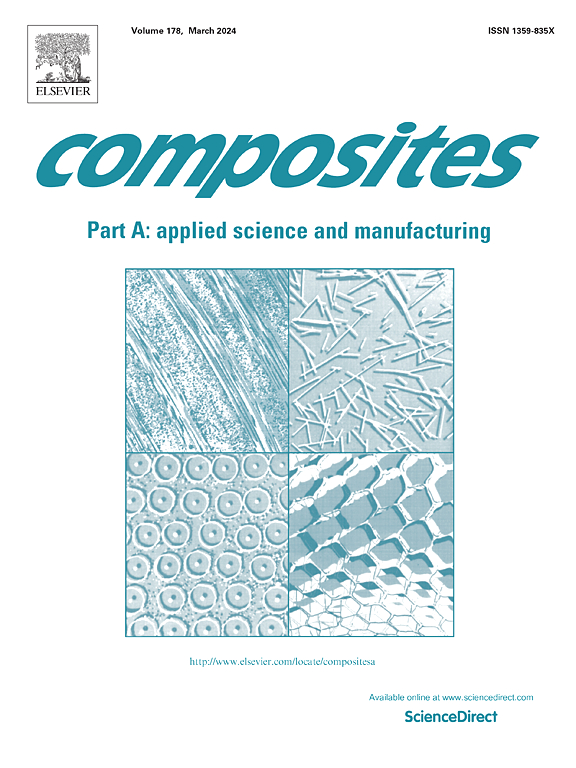熔融沉积模型中短碳纤维增强PLA的微观结构变化及其对有效刚度的影响
IF 8.1
2区 材料科学
Q1 ENGINEERING, MANUFACTURING
Composites Part A: Applied Science and Manufacturing
Pub Date : 2025-08-15
DOI:10.1016/j.compositesa.2025.109229
引用次数: 0
摘要
研究了短碳纤维增强聚乳酸(CF-PLA)长丝在熔融沉积成型(FDM)打印过程中的微观结构变化及其对打印件有效弹性模量的影响。采用综合实验方案,包括热重分析(TGA)、显微摄影和微计算机断层扫描(µ-CT)来表征关键的微观结构参数,如纤维体积分数、长宽比和纤维取向分布。此外,在三个光栅方向(0°,±45°和90°)打印的样品上进行单轴拉伸测试,以表征机械响应。实验揭示了FDM打印过程中显著的纤维错位、纤维断裂和基体降解,所有这些都导致了杨氏模量的大幅降低。为了解释实验结果,开发了两种新的三尺度均匀化模型(Mori-Tanaka-Finite Element和Fully Finite Element),整合微观、中观和宏观尺度数据,预测不同光栅方向的有效刚度,误差分别低于5%和7%。该框架的一个关键创新是引入了一个退化参数,以解释打印过程中基体的退化。参数化研究发现纤维断裂是最重要的因素,造成27.15%的刚度损失,其次是错位(15.54%)和基体退化(10.74%)。这一整体框架结合了实验和计算方法,阐明了工艺-结构-性能关系,为fdm打印短纤维增强复合材料的结构应用提供了新的见解。本文章由计算机程序翻译,如有差异,请以英文原文为准。
Microstructural alteration and its impact on the effective stiffness of short carbon fiber-reinforced PLA in fused deposition modeling
This study investigates the change in microstructure of short carbon fiber-reinforced polylactic acid (CF-PLA) filaments during fused deposition modeling (FDM) printing and its impact on the effective elastic modulus of printed parts. A comprehensive experimental protocol is employed, including thermogravimetric analysis (TGA), photomicrography, and micro-computed tomography (µ-CT) to characterize key microstructural parameters such as fiber volume fraction, aspect ratio, and fiber orientation distribution. Additionally, uniaxial tensile tests are performed on specimens printed in three raster orientations (0°, ±45°, and 90°) to characterize mechanical response. The experiments reveal significant fiber misalignment, fiber breakage, and matrix degradation during FDM printing, all contributing to a substantial reduction in Young’s modulus.
To interpret the experimental observations, two novel tri-scale homogenization models (Mori-Tanaka-Finite Element and Fully Finite Element) were developed, integrating micro-, meso-, and macro-scale data to predict effective stiffness with errors below 5% and 7%, respectively, across various raster orientations. A key innovation in this framework is the introduction of a degradation parameter to account for matrix deterioration during printing. Parametric studies identified fiber breakage as the most significant factor, causing a 27.15% stiffness loss, followed by misalignment (15.54%) and matrix degradation (10.74%). This holistic framework, combining experimental and computational approaches, elucidates process-structure–property relationships, offering a new insights about FDM-printed short fiber-reinforced composites for structural applications.
求助全文
通过发布文献求助,成功后即可免费获取论文全文。
去求助
来源期刊

Composites Part A: Applied Science and Manufacturing
工程技术-材料科学:复合
CiteScore
15.20
自引率
5.70%
发文量
492
审稿时长
30 days
期刊介绍:
Composites Part A: Applied Science and Manufacturing is a comprehensive journal that publishes original research papers, review articles, case studies, short communications, and letters covering various aspects of composite materials science and technology. This includes fibrous and particulate reinforcements in polymeric, metallic, and ceramic matrices, as well as 'natural' composites like wood and biological materials. The journal addresses topics such as properties, design, and manufacture of reinforcing fibers and particles, novel architectures and concepts, multifunctional composites, advancements in fabrication and processing, manufacturing science, process modeling, experimental mechanics, microstructural characterization, interfaces, prediction and measurement of mechanical, physical, and chemical behavior, and performance in service. Additionally, articles on economic and commercial aspects, design, and case studies are welcomed. All submissions undergo rigorous peer review to ensure they contribute significantly and innovatively, maintaining high standards for content and presentation. The editorial team aims to expedite the review process for prompt publication.
 求助内容:
求助内容: 应助结果提醒方式:
应助结果提醒方式:


